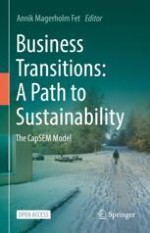10.1 Background
10.2 BMfS Concepts
Concept | Definition |
|---|---|
Business model (BM) | “A business model describes the rationale of how an organization creates, delivers, and captures value” (Osterwalder and Pigneur 2010:14). |
Business model for sustainability (BMfS) | “A business model for sustainability helps describing, analyzing, managing, and communicating (i) a company’s sustainable value proposition to its customers, and all other stakeholders, (ii) how it creates and delivers this value, (iii) and how it captures economic value while maintaining or regenerating natural, social, and economic capital beyond its organizational boundaries” (Schaltegger et al. 2016: 6). |
Business model innovation (BMI) | “The conceptualisation and implementation of new business models. This can comprise the development of entirely new business models, the diversification into additional business models, the acquisition of new business models, or the transformation from one business model to another. The transformation can affect the entire business model or individual or a combination of its value proposition, value creation and deliver, and value capture elements, the interrelations between the elements, and the value network” (Geissdoerfer et al. 2018: 405–406). |
Business model innovation for sustainability (BMIfS) | “The conceptualisation and implementation of sustainable business models.” (Geissdoerfer et al. 2018: 405–406). “Sustainable business innovation processes specifically aim at incorporating sustainable value and a pro-active management of a broad range of stakeholders into the business model” (Geissdoerfer et al. 2016: 1220). |
10.2.1 Business Models
10.2.2 Business Models for Sustainability
10.2.3 Business Model Innovation for Sustainability
10.3 Developing a Business Model for Sustainability
-
Treating sustainability as a strategy in itself
-
Using triple-bottom-line reporting for measuring and communicating progress e.g., SDG targets and indicators or the Global Reporting Initiative (GRI)
-
Taking the stakeholder view of the organization
-
Embedding sustainability into top management so it makes its way into organization processes and culture
-
Recognizing nature and the environment as key stakeholders
10.3.1 Mapping a Business Model for Sustainability
10.3.2 Business Model for Sustainability Archetypes
Archetype | Value proposition | Value creation and delivery | Value capture | |
|---|---|---|---|---|
Technical | Maximize material and energy efficiency | Products/services using less resources, generating less waste and emissions | Adopting more efficient and safe production processes | Reducing costs, minimizing environmental impact |
Create value from waste | Turning waste into higher value products/services | Using recycled materials, ensuring recyclability of products/services | Reducing costs, as well as waste and virgin material use | |
Substitute with renewables and natural processes | Products/services using bio-based renewable materials and energy | Adopting innovative production processes based on bio-based materials and energy | Commercializing new products/services, reducing environmental impact | |
Social | Deliver functionality, rather than ownership | Shifting from a consumer to a user logic | Enabling product/service reuse and reparation | Commercializing user-based solutions, reducing material use, enabling consumer access to expensive products/ services without owning |
Adopt a stewardship role | Providing access to more sustainable alternatives | Seeking resource co-management and transparency in supply chains | Securing a customer base by leveraging stewardship of social and ecological systems | |
Encourage sufficiency | Products /services that reduce demand or consumption | Promoting responsible consumption and frugality (e.g., by ensuring product/service longevity) | Encouraging premium pricing, customer loyalty, increased market share, reducing material use | |
Organizational | Repurpose the business for society/the environment | Prioritizing social and environmental benefits along with economic profit | Developing hybrid business, cooperatives | Establishing a new business while securing livelihoods and/or supporting natural systems |
Develop scale-up solutions | Expanding product/ service commercialization | Developing adequate infrastructure and partnering with additional operators | Sharing and promoting sustainability-oriented businesses, e.g., through licensing |
